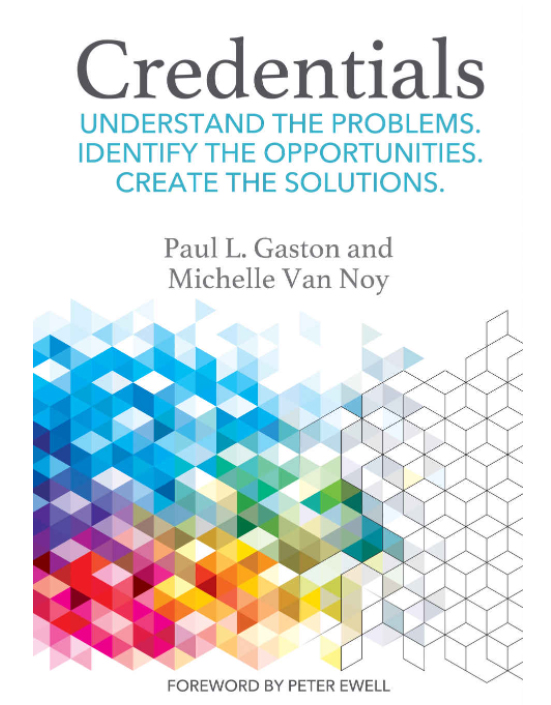Most recent discussions of postsecondary workforce development trends ultimately focus on credentials. The term is often used to define diverse educational activities such as short-term stackable certificates, industry-created certifications, licenses, non-degree certificates, apprenticeships or electronic badges. These various methods of acquiring skills are often aggregated together with little explanation of the differences between them. Some credential advocates separate credentials from academic degrees, assuming they are two distinctly different pathways for acquiring skills.

Finally, we have a book that tries to clarify the terrain of credentials. Michelle Van Noy and Paul Gaston have produced a book that aids in distinguishing among these terms and helps unwrap the critical issues associated with them. The book attempts to define these different credentials and discuss their implications for learning. Credentials is written for postsecondary educators attempting to bring clarity to this diffuse array of activities. It makes some critical distinctions that will elevate our understanding of credentials and lead to more realistic approaches to their utilization.
One of the most important contributions Gaston and Van Noy make is their insistence that postsecondary educational degrees should not be separated from credentials. Instead, they correctly identify degrees as a form of credentials — and indeed, as the data indicate, they remain the most significant postsecondary credential utilized by those seeking employment. Indeed, they explore the development of degrees on all higher education levels. Their discussion should be an eye-opening one for many who tend to see the degrees as static artifacts unrelated to the needs of employers. It should also help rest the false distinction between “academic” and “vocational” programs at postsecondary institutions.
Mulling non-degrees

The authors also recognize that the non-degree field is still only emerging very slowly. According to the National Center of Educational Statistics, in 2017-2018 there were a little over 950,000 non-degree credentials earned, while almost 4 million postsecondary degrees were awarded in the same period. That is 23% of the market share, up from 21% in the previous years. Non-degree credentials remain risky and volatile investments, and their multiple forms make it difficult for individuals or institutions to know which ones will lead to sustainable employment.
Still, the authors argue that credentials other than degrees have great weight in many specific fields and many localities. Credentials of value are inexpensive means for immediate employment and potential career connections in many sectors. Also, many credentials are based on competency models, which give employers a much clearer perspective on what students can do. This may be the fastest means of achieving sustainable wage jobs for many low-income individuals. On the other hand, the proliferation of credentials often makes it difficult for colleges or students to determine value. Employers, which could play a decisive role, are often reluctant to express a preference.
Issues of equity
Gaston and Van Noy lean toward utilizing local or regional labor market considerations to determine which credentials might make a difference. They also argue for degrees with credentials embedded within them, so the two are complementary. Credentials alone might freeze individuals, particularly students of color, in jobs that will not lead to careers.
One of the most significant advances made in this book is to connect issues of quality credentials to issues of equity. For Gaston and Van Noy, it is impossible to implement any credentials (including degrees) without intentional steps made by educators to include issues of equity. This includes whether instruction exemplifies effective pedagogy and cultural competence and whether the instruction is provided by a faculty whose diversity reflects the student body. These and other suggestions discussed in the book make a significant addition to any criteria of quality credentials that all workforce development practitioners need to consider.
Things to consider
Since this is an introduction to credentials, the authors may have moved too quickly over topics that seem central to their utilization within a postsecondary environment. While the authors point out regional differences in employer selection and utilization of credentials, it would have been helpful to offer some examples of how this might work. Second, there is a brief discussion of competency-based education, but its relationship to degrees and other credentials should have been explored. Third, as a response to Covid, some of the recent non-degree credentials are dependent on simulation, artificial intelligence and other computer-based learning technologies. The authors might have discussed how those new technologies are interrelated with the pedagogy of credentials and their implications for teaching and learning low-income students noted.
Finally, outside of the discussion of apprenticeship, there is too little recognition that employers increasingly depend upon their workplaces as the site for much occupational learning. How credentials in education tie into work-based learning employer strategies is an area that needs more exploration. The forces on credentials in higher education should not ignore the preparation for learning at the workplace. Gaston and Van Noy have given us a vital premier on credentials, and it is up to us to build upon these impressive efforts.
Related article: Q&A: A closer look at credentials





